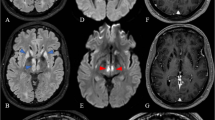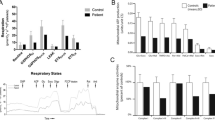Abstract
Our knowledge of molecular mechanisms underlying mitochondrial disorders in humans has increased considerably during the past two decades. Mitochondrial encephalomyopathies have sporadically been reported in dogs. However, molecular and biochemical data that would lend credence to the suspected mitochondrial origin are largely missing. This study was aimed to characterise a Leigh-like subacute necrotising encephalopathy (SNE) in Yorkshire Terriers and to shed light on its enzymatic and genetic background. The possible resemblance to SNE in Alaskan Huskies and to human Leigh syndrome (LS) was another focus of interest. Eleven terriers with imaging and/or gross evidence of V-shaped, non-contiguous, cyst-like cavitations in the striatum, thalamus and brain stem were included. Neuropathological examinations focussed on muscle, brain pathology and mitochondrial ultrastructure. Further investigations encompassed respiratory-chain activities and the mitochondrial DNA. In contrast to mild non-specific muscle findings, brain pathology featured the stereotypic triad of necrotising grey matter lesions with relative preservation of neurons in the aforementioned regions, multiple cerebral infarcts, and severe patchy Purkinje-cell degeneration in the cerebellar vermis. Two dogs revealed a reduced activity of respiratory-chain-complexes I and IV. Genetic analyses obtained a neutral tRNA-LeuUUR A-G-transition only. Neuropathologically, SNE in Yorkshire Terriers is nearly identical to the Alaskan Husky form and very similar to human LS. This study, for the first time, demonstrated that canine SNE can be associated with a combined respiratory chain defect. Mitochondrial tRNA mutations and large genetic rearrangements were excluded as underlying aetiology. Further studies, amongst relevant candidates, should focus on nuclear encoded transcription and translation factors.









Similar content being viewed by others
References
Braund KG (2003) Degenerative disorders of the central nervous system. International Veterinary Information Service. Ithaca. http://www.ivis.org.
Brenner O, de Lahunta A, Cummings JF, Summers BA, Monachelli M (1997) A canine encephalomyelopathy with morphological abnormalities in mitochondria. Acta Neuropathol (Berl) 94:390–397
Brenner O, Wakshlag JJ, Summers BA, de Lahunta A (2000) Alaskan Husky encephalopathy—a canine neurodegenerative disorder resembling subacute necrotizing encephalomyelopathy (Leigh syndrome). Acta Neuropathol (Berl) 100:50–62
Campos Y, Martin MA, Lorenzo G, Aparicio M, Cabello A, Arenas J (1996) Sporadic MERRF/MELAS overlap syndrome associated with the 3243 tRNA(Leu(UUR)) mutation of mitochondrial DNA. Mus Nerv 19:187–190
Cavanagh JB, Harding BN (1994) Pathogenic factors underlying the lesions in Leigh’s disease: tissue responses to cellular energy deprivation and their clinico- pathological consequences. Brain 117(Pt 6):1357–1376
Coenen MJ, Antonicka H, Ugalde C et al (2004) Mutant mitochondrial elongation factor G1 and combined oxidative phosphorylation deficiency. N Engl J Med 351:2080–2086
Darin N, Oldfors A, Moslemi AR, Holme E, Tulinius M (2001) The incidence of mitochondrial encephalomyopathies in childhood: clinical features and morphological, biochemical, and DNA anbormalities. Ann Neurol 49:377–383
DiMauro S, De Vivo DC (1996) Genetic heterogeneity in Leigh syndrome. Ann Neurol 40:5–7
Fabrizi GM, Cardaioli E, Grieco GS et al (1996) The A to G transition at nt 3243 of the mitochondrial tRNALeu(UUR) may cause an MERRF syndrome. J Neurol Neurosurg Psychiatry 61:47–51
Filosto M, Tomelleri G, Tonin P et al (2007) Neuropathology of mitochondrial diseases. Biosci Rep 27:23–30
Fischer JC, Ruitenbeek W, Gabreels FJ et al (1986) A mitochondrial encephalomyopathy: the first case with an established defect at the level of coenzyme Q. Eur J Pediatr 144:441–444
Goto Y, Nonaka I, Horai S (1990) A mutation in the tRNA(Leu)(UUR) gene associated with the MELAS subgroup of mitochondrial encephalomyopathies. Nature 348:651–653
Gruber AD, Wessmann A, Vandevelde M, Summers BA, Tipold A (2002) Mitochondriopathy with regional encephalic mineralization in a Jack Russell Terrier. Vet Pathol 39:732–736
Hao R, Yao YN, Zheng YG, Xu MG, Wang ED (2004) Reduction of mitochondrial tRNALeu(UUR) aminoacylation by some MELAS-associated mutations. FEBS Lett 578:135–139
Helm M, Brule H, Friede D, Giege R, Putz D, Florentz C (2000) Search for characteristic structural features of mammalian mitochondrial tRNAs. RNA 6:1356–1379
Holt IJ, Harding AE, Morgan-Hughes JA (1988) Deletions of muscle mitochondrial DNA in patients with mitochondrial myopathies. Nature 331:717–719
Kern AD, Kondrashov FA (2004) Mechanisms and convergence of compensatory evolution in mammalian mitochondrial tRNAs. Nat Genet 36:1207–1212
Koga Y, Akita Y, Takane N, Sato Y, Kato H (2000) Heterogeneous presentation in A3243G mutation in the mitochondrial tRNA(Leu(UUR)) gene. Arch Dis Child 82:407–411
Leigh D (1951) Subacute necrotizing encephalomyelopathy in an infant. J Neurol Neurosurg Psychiatry 14:216–221
Li FY, Cuddon PA, Song J et al (2006) Canine spongiform leukoencephalomyelopathy is associated with a missense mutation in cytochrome b. Neurobiol Dis 21:35–42
McFarland R, Clark KM, Morris AA et al (2002) Multiple neonatal deaths due to a homoplasmic mitochondrial DNA mutation. Nat Genet 30:145–146
Moraes CT, Ciacci F, Silvestri G et al (1993) Atypical clinical presentations associated with the MELAS mutation at position 3243 of human mitochondrial DNA. Neuromuscul Disord 3:43–50
Obayashi T, Hattori K, Sugiyama S et al (1992) Point mutations in mitochondrial DNA in patients with hypertrophic cardiomyopathy. Am Heart J 124:1263–1269
Rahman S, Blok RB, Dahl HH et al (1996) Leigh syndrome: clinical features and biochemical and DNA abnormalities. Ann Neurol 39:343–351
Silvestri G, Bertini E, Servidei S et al (1997) Maternally inherited cardiomyopathy: a new phenotype associated with the A to G AT nt.3243 of mitochondrial DNA (MELAS mutation). Mus Nerv 20:221–225
Smeitink J, van den Heuvel L, DiMauro S (2001) The genetics and pathology of oxidative phosphorylation. Nat Rev Genet 2:342–352
Sohm B, Frugier M, Brule H, Olszak K, Przykorska A, Florentz C (2003) Towards understanding human mitochondrial leucine aminoacylation identity. J Mol Biol 328:995–1010
Southern EM (1975) Detection of specific sequences among DNA fragments separated by gel electrophoresis. J Mol Biol 98:503–517
Tanji K, Kunimatsu T, Vu TH, Bonilla E (2001) Neuropathological features of mitochondrial disorders. Semin Cell Dev Biol 12:429–439
Valente L, Tiranti V, Marsano RM et al (2007) Infantile encephalopathy and defective mitochondrial DNA translation in patients with mutations of mitochondrial elongation factors EFG1 and EFTu. Am J Hum Genet 80:44–58
van den Ouweland JM, Lemkes HH, Ruitenbeek W et al (1992) Mutation in mitochondrial tRNA(Leu)(UUR) gene in a large pedigree with maternally transmitted type II diabetes mellitus and deafness. Nat Genet 1:368–371
Verma A, Moraes CT, Shebert RT, Bradley WG (1996) A MERRF/PEO overlap syndrome associated with the mitochondrial DNA 3243 mutation. Neurology 46:1334–1336
Vilarinho L, Maia C, Coelho T, Coutinho P, Santorelli FM (1997) Heterogeneous presentation in Leigh syndrome. J Inherit Metab Dis 20:704–705
Wakshlag JJ, de Lahunta A, Robinson T et al (1999) Subacute necrotising encephalopathy in an Alaskan husky. J Small Anim Pract 40:585–589
Wallace DC, Singh G, Lott MT et al (1988) Mitochondrial DNA mutation associated with Leber’s hereditary optic neuropathy. Science 242:1427–1430
Wittenhagen LM, Kelley SO (2002) Dimerization of a pathogenic human mitochondrial tRNA. Nat Struct Biol 9:586–590
Wittenhagen LM, Kelley SO (2003) Impact of disease-related mitochondrial mutations on tRNA structure and function. Trends Biochem Sci 28:605–611
Acknowledgments
We thank Bettina Treske and Karin Stingl for excellent technical assistance. This work was supported by the Deutsche Forschungsgesellschaft to M.F·B. (Ba1438/3 and 4) and to S·H. (Ho2374/1-1).
Author information
Authors and Affiliations
Corresponding author
Additional information
S. Hofmann and M. F. Bauer contributed equally.
Rights and permissions
About this article
Cite this article
Baiker, K., Hofmann, S., Fischer, A. et al. Leigh-like subacute necrotising encephalopathy in Yorkshire Terriers: neuropathological characterisation, respiratory chain activities and mitochondrial DNA. Acta Neuropathol 118, 697–709 (2009). https://doi.org/10.1007/s00401-009-0548-6
Received:
Revised:
Accepted:
Published:
Issue Date:
DOI: https://doi.org/10.1007/s00401-009-0548-6




